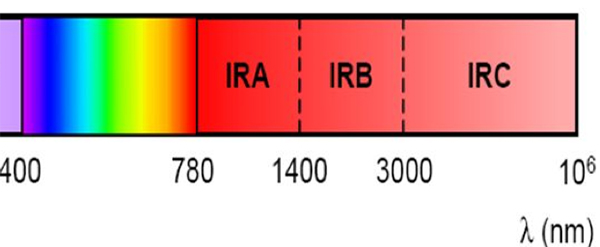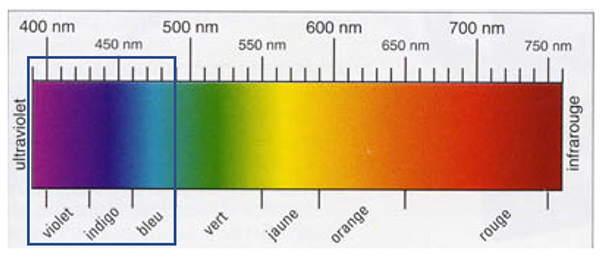Until very recently, the talk about sun protection was focused on ultraviolet (UVs): UVB [280-315 nm] then UVA [315-380 nm].
Indeed, these high energy radiations that lead to the appearance of tanning also cause the appearance of erythema, free radicals and premature ageing.
However, UVs represent only 7% of radiation reaching the earth's surface; the remainder consists of visible light (46%) and infrared (IR) (47%) (Figure 1).
In the 1990s, the first claims concerning cutaneous protection against IR appeared [1] but it was not until the end of the 2000s that this argument was more widely used by brands.
At the same time, attention has been focused on the impact of visible light on our skin, and more particularly the blue light that invades our environment via screens, tablets, smartphones and other electronic devices.

Figure 2: Average spectrum of visible radiation emitted by screens
Infrared
The IR spectrum extends from 780 to 106 nm and decomposes to IRA [780-1480 nm], IRB [1480-3000 nm] and IRC [3-1000 μm] (Figure 3).

Figure 3: Splitting of the infrared spectrum
While sunscreens protect against UV radiation, several studies point out the deleterious impact of IR and the fact that IR protection should also be added to products [2-4].
Indeed, IR are involved in skin ageing and probably in carcinogenesis [5]; they are mainly responsible for the increase of skin temperature and lead to the production of free radicals and metalloproteinases-1 (MMP-1) in the dermis [6-8].
Effective protection against IR can be achieved by adding absorbing optical filters in the IR range, free radical scavengers and / or photon reflection [9].
Dermscan proposes to evaluate the protective effect of cosmetics against infrared by complementary approaches, after IR irradiation [10]:
- biometric approach: cutaneous measures of color and/or temperature and/or microcirculation
- biochemical approach: lipid oxidation assays (SQOOH, MDA) and/or enzymes (CAT, SOD)
Blue light
The spectrum of blue light extends from 380 to 490 nm, passing from violet to indigo then to blue (Figure 4).

Figure 4: Splitting of visible light
Recent studies have shown that this type of light - especially short wavelengths around 415 nm - could lead to erythema, free radical production and long-lasting hyperpigmentation in phototype subjects III and more [11,12].
Current chemical filters are not able to block visible light, and blue light in particular. Only mineral filters can - depending on the size of the particles - filter blue radiation [11].
Another approach is to add anti-oxidants to the cosmetic formulas to limit accelerated skin ageing and damage caused by blue light [13].
Dermscan offers different approaches to evaluate the anti-blue light protective effect at the level of the skin:
- Irradiation (single or repeated) in blue light (peak at 415 nm) followed by evaluation of β-carotene oxidation, protein carbonylation, lipid oxidation or pigmentation.
- Test in real conditions, on subjects regularly exposed to the screens of electronic devices: effect on the radiance of the complexion and the cutaneous fatigue.
To find out more about test protocol contact Dermscan at commercial@dermscan.com
Bibliography
1. Violin L, Girard F, Girard P, Meille JP, Petit-Ramel M. Infra-red photoprotection properties of cosmetic products. Correlation between measurement of the anti-erythemic effect in vivo in man and the infra-red reflection power in vitro. Int J Cosm Sci. 1994; 16: 113-120.2. Schroeder P, Calles C, Benesova T, et al. Photoprotection beyond ultraviolet radiation - Effective sun protection has to include protection against infrared A radiation-induced skin damage. Skin Pharmacol Physiol. 2010; 23: 15-17.
3. Krutmann J, Morita A, Chung JH. Sun exposure: what molecular photodermatology tells us about its good and bad sides. J Invest Dermatol. 2012; 132: 976-84.
4. Dupont E, Gomez J, Bilodeau D. Beyond UV radiation: a skin under challenge. Int. J. Cosm. Sci. 2013; 35:224-232.
5. Kim MS, Kim YK, Cho KH, Chung JH. Regulation of type I procollagen and MMP-1 expression after single or repeated exposure to infrared radiation in human skin. 2006; 127: 875-822.
6. Cho S, Lee MJ, Kim MS et al. Infrared plus visible light and heat from natural sunlight participate in the expression of MMPs and type I procollagen as well as infiltration of inflammatory cell in human skin in vivo. J Dermatol Sci. 2008; 50: 123-133.
7. Schroeder P, Lademann J, Darvin ME, et al. Infrared radiation-induced matrix metalloproteinase in human skin: implications for protection. J Invest Dermatol. 2008; 128: 2491-2497.
8. Darvin ME, Haag SF, Lademann J et al. Formation of free radicals in human skin during irradiation with infrared light. J Invest Dermatol. 2010; 130: 629-631.
9. Meinke M, Haag SF, Schanzer S et al. Radical protection by sunscreens in the infrared spectral range. Photochem Photobiol. 2011; 87:452-456.
10. Sirvent A, Lhéritierc, Moga A, Girard-Ory F. Evaluation of the anti-infra-red protection of cosmetic products, in vivo. 28th Congress of the IFSCC, October 26-30, 2014; Paris – France.
11. Bassel HM, Hexsel CL, Hamzavi IH, Lim HW. Effects of visible light on the skin. Photochem Photobiol. 2008; 84: 450-462.
12. Regazzetti C, Sormani L, Debayle D et al. Melanocytes sense blue light and regulate pigmentation through Opsin-3. J Invest Dermatol. 2018; 138: 171-178.
13. Liebel F, Kaur S, Ruvolo E, Kollias N, Southall MD. Irradiation of skin with visible light induces reactive oxygen species and matrix-degrading enzymes. J Invest Dermatol. 2012; 132: 1901-1907.
